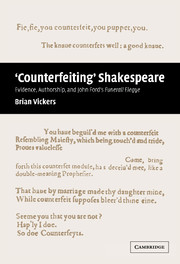Book contents
Bibliography
Published online by Cambridge University Press: 10 December 2009
- Type
- Chapter
- Information
- 'Counterfeiting' ShakespeareEvidence, Authorship and John Ford's Funerall Elegye, pp. 554 - 562Publisher: Cambridge University PressPrint publication year: 2002



